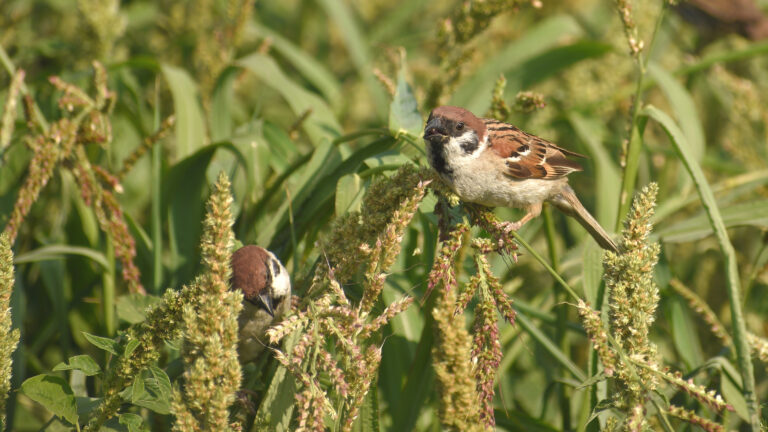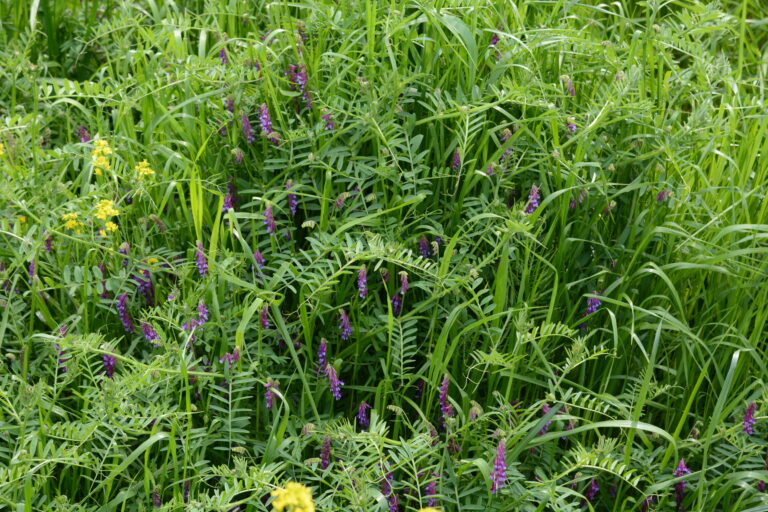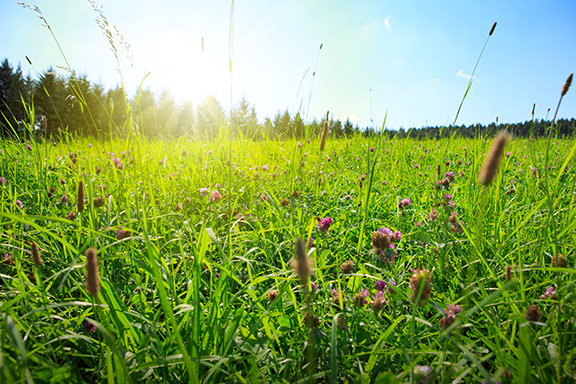SFI Seed Mixes
Have a look at our extensive range of highly productive SFI seed mixtures. Our superior seed range covers organic and conventional farming systems and each mix has been designed to comply with specific SFI actions.
CAHL1/AHL 1 - Pollen & Nectar Flower Mix

AHL 1 - Organic Pollen & Nectar
40% Organic Vetch
20% Organic Red Clover
10% Organic Lucerne (Pre Innoc.)
6% Alsike Clover
8% Sweet Yellow Clover
10% Sainfoin
3% Birdsfoot Trefoil
0.5% Wild Carrot
0.5% Black Knapweed
1% Yarrow
0.75% Oxeye Daisy
0.25% Musk Mallow
Suggested sowing rate 5kg/ac

AHL 1 - Pollen & Nectar Silver
- 25% Buckwheat
- 25% Linseed
- 20% Vetch
- 15% Crimson Clover
- 10% Berseem Clover
- 4.6% Phacelia
- 0.2% Black Knapweed
- 0.2% Ag Yarrow
Suggested sowing rate 6kg per acre

AHL 1 - Pollen & Nectar Gold
- 33% Sainfoin
- 25% Vetch
- 10% Red Clover
- 8% Alsike Clover
- 8% Lucerne (inoculated)
- 6.5% Crimson Clover
- 4% Birdsfoot Trefoil
- 4% Yellow Trefoil
- 1% Black Knapweed
- 0.5% Yarrow
Suggested sowing rate 6kg/acre
CAHL2/AHL 2 - Winter Bird Food on Arable & Horticultural Land

AHL 2 - Organic Wild Bird Food
Organic Wild Bird Food
- 65% Organic Triticale/Barley
- 5% Organic Mustard
- 3% R/C Kale
- 4% R/C Quinoa
- 10% R/C Linseed
- 10% R/C Fodder Radish
- 3% R/C Red/White Millet
Suggested sowing rate 50kg per hectare

AHL 2 - Winter Bird Food Gold - With Sunflowers
- 60% Spring Triticale
- 15% Sunflower
- 8% Quinoa
- 4% Kale/Kale x Rape Hybrid
- 8% Fodder Radish
- 5% Millets
Suggested sowing rate 50kg per hectare

AHL 2 - Winter Bird Food Gold - Without Sunflowers
- 65% Spring Triticale
- 8% Quinoa
- 7% Kale/Kale x Rape Hybrid
- 10% Fodder Radish
- 10% Millets
Suggested sowing rate 50kg per hectare

AHL 2 - Winter Bird Food Bronze
- 40% Spring Triticale
- 28% Spring Barley
- 15% Spring Wheat
- 10% Fodder Radish
- 5% White Millet
- 2% Red Millet
Suggested sowing rate 40kg per hectare

AHL 2 - Winter Bird Food Silver
- 45% Spring Triticale
- 20% Spring Barley
- 15% Spring Wheat
- 7% Kale
- 4% Fodder Radish
- 4% White Millet
- 3% Quinoa
- 2% Red Millet
Suggested sowing rate 40kg per hectare
CAHL3-4/AHL 3-4 - Grassy Field Corners, Blocks & Margins

AHL 3/4 - Organic Arable Reversions
- 20% Organic Meadow Fescue
- 10% Smooth Stalked Meadow Grass
- 10% Sheeps Fescue
- 20% Organic Timothy
- 5% Common Bent Grass
- 30% Organic Creeping Red Fescue
- 5% Crested Dogstail
Suggested sowing rate 30kg per hectare

AHL 3 - Grassy Corners & Blocks - No Cocksfoot
- 37% Creeping Red Fescue
- 22% Chewings Fescue
- 22% Tall Fescue
- 12% SSMG
- 7% Timothy
Suggested sowing rate 20kg per hectare

AHL 3 - Grassy Corners & Blocks - With Cocksfoot
- 45% Creeping Red Fescue
- 20% Cocksfoot
- 20% Tall Fescue
- 10% SSMG
- 5% Timothy
Suggested sowing rate 20kg/ha

AHL 3/4 - Organic Grassy Corners & Blocks
- 20% Organic Timothy
- 20% Organic Meadow Fescue
- 25% Organic Creeping Red Fescue
- 10% Organic Cocksfoot
- 5% Common Bent
- 10% Smooth Stalked Meadow Grass
- 10% Chewings Fescue
Suggested sowing rate 25kg per hectare
AHL 4 - 4-12m Grass Buffer Strips

AHL 4 - Watercourse Buffer Strips
- 15% Tall Fescue
- 20% Sheep / Hard Fescue
- 20% Timothy
- 10% Smooth Stalked Meadow Grass
- 35% Creeping Red Fescue
Suggested sowing rate 25kg per hectare

AHL 4 - Reestablish Grassland
- 20% Meadow Fescue
- 10% Smooth Stalked Meadow Grass
- 15% Sheeps Fescue
- 20% Timothy
- 5% Common Bent Grass
- 25% Red Fescue
- 5% Crested Dogstail
Suggested sowing rate 30kgs per hectare
CIPM2/IPM 2 - Flower Rich Grass Margins, Clocks & In-Field Strips

IPM 2 - 10% Wildflowers Gold
Grass Species
- 25% Slender Red Fescue
- 25% SSMG
- 12% Chewings Fescue
- 10% Crested Dogstail
- 5% Hard Fescue
Flowering Species
- 3.25% Sainfoin
- 3% Vetch
- 3% Browntop Bent
- 2.5% Birdsfoot Trefoil
- 2% Black Medick
- 2% Red Clover
- 2% Black Knapweed
- 1.3% Oxeye Daisy
- 1.25% Yarrow
- 1% Wild Carrot
- 1% Plantain
- 0.5% Selfheal
- 0.20% Musk Mallow
Suggested sowing rate 16-20kg per hectare

IPM 2 - 10% Wildflowers Silver
Grasses Species
- 3% Crested Dogstail
- 2% Smooth Stalked Meadow Grass
- 20% Sheeps Fescue
- 36% Red Fescue
- 20% Chewings Fescue
- 5% Meadow Fescue
- 4% Timothy
Flowering Species
- 1.00% Yarrow
- 0.50% Salad Burnet
- 1.00% Phacelia
- 0.25% Oxeye Daisy
- 0.50% Vipers Buglos
- 0.50% Corn Cockle
- 1.00% Wild Carrot
- 2.50% Vetch
- 0.50% Meadow Sweet
- 0.50% Common Mallow
- 1.00% Sainfoin
- 0.50% Agrimony
- 0.25% Red Clover
Suggested sowing rate 20kg per hectare

IPM 2 - 10% Wildflowers Bronze
Grass species
- 45% Creeping Red Fescue
- 15% Chewings Fescue
- 15% Hard Fescue
- 15% SSMG
Flowering Species
- 2.5% Sainfoin
- 2.5% Vetch
- 1.5% Red Clover
- 1.25% Alsike Clover
- 0.75% Plantain
- 0.5% Birdsfoot Trefoil
- 0.25% Black Knapweed (N)
- 0.25% Oxeye Daisy
- 0.25% Sheeps Burnet
- 0.25% Yarrow
Suggested sowing rate 16-20kg per hectare

IPM 2 - Organic
- 90% Grasses
45% Organic Meadow Fescue
10% Organic Timothy
15% Organic Cocksfoot
20% Maxima Creeping Red Fescue
5% Wagner Chewings Fescue
5% Evora SSMG10% Flowering Species
1% Yarrow
0.50% Salad Burnet
0.25% Oxeye Daisy
0.50% Vipers Buglos
0.50% Corn Cockle
1% Wild Carrot
2.50% Ebena Vetch
0.50% Meadow Sweet
0.50% Common Mallow
0.50% Agrimony
1% Phacelia
1% Sainfoin
0.25% Red CloverSuggested sowing rate 8kg/acre
CIPM3/IPM 3 - Companion crop on arable and horticultural land
As the name suggests, you must establish a companion crop so that it is growing with the main arable or horticultural crop.
The companion crop does not have to be present for the full growing period of the main crop as long as it is managed in a way that can reasonably be expected to achieve the action’s aim and it’s intended purpose.
This must be done each year of the 3 year agreement.
You can establish a companion crop by:-
- Trap Cropping – sowing a trap crop to attract pests away form a main arable or horticultural crop
- Inter-cropping – sow a companion crop with the main arable or horticultural crop
- Undersowing – sowing a companion crop to form a living mulch beneath an arable or horticultural crop
Deep rooted species should be avoided on any area within a land parcel that contains historic or archaeological features. Legumes should not be used on peaty soils – the criteria for it to be classed as peaty soil is if there is 20% or more organic matter to a depth of 40cm or more.

CNUM/NUM - Nutrient Management

NUM 2 - Existing Sward Mixture
The suggested mixture for adding legumes to an existing sward would be:-
- 60% Red Clover
- 25% White Clover
- 15% Alsike Clover
The suggested seeding rate would be 7.5-10 kilos per hectare

NUM 3 - Gold - No Grasses (2-year)
- 52% Vetch
- 12% Alsike Clover
- 12% Crimson Clover
- 12% Lucerne (inoculated)
- 10% Red Clover
- 1% Birdsfoot Trefoil
- 1% Yellow Trefoil
Suggested sowing rate 15-20kg per hectare

NUM 3 - With Grasses (2-year)
- 36% Perennial Ryegrass
- 30% Creeping Red Fescue
- 10% Crimson Clover
- 10% Vetch
- 5% Red Clover
- 4% Lucerne (inoculated)
- 3% Alsike Clover
- 1% Birdsfoot Trefoil
- 1% Yellow Trefoil
Suggested sowing rater 30-40kg per hectare

NUM 3 - Organic - With Grass
- 40% Organic Vetch
- 10% Organic Red Clover
- 12% Alsike Clover
- 10% Lucerne
- 6% Sweet Yellow Clover
- 2% Yellow Trefoil
- 12% Organic Timothy
- 8% Organic Cocksfoot
Suggested sowing rate 12kg/acre

NUM 3 - Organic - No Grass
- 52% Organic Vetch
- 12% Alsike Clover
- 12% Organic Crimson Clover
- 12% Lucerne (inoculated)
- 10% Organic Red Clover
- 1% Birdsfoot Trefoil
- 1% Yellow Trefoil
Suggested sowing rate 8kg/acre

NUM 3 - Silver - No Grasses
- 10% Alex Berseem Clover
- 20% Contea Crimson Clover
- 50% Vetch
- 10% Sainfoin
- 5% Alsike Clover
- 5% Sweet Yellow Blossom Clover
Suggested sowing rate 25kg per hectare
SAM 2 - Multi-species winter cover
The requirement is to establish a multi-species cover crop mixture containing at least 2 species from the following list:-
Brassicae, Legumes, Grass, Cereals, Herbs
Many of our standard cover crop mixtures would meet this criteria as would a grass ley. There are the following management rules apply:-
- No legumes are to be sown on peaty soils – the criteria for it to be classed as peaty soil is if there is 20% or more organic matter to a depth of 40cm or more
- Cover Crop must be fully established over the winter months
- No Fertiliser or Manure is to be applied
- Can be grazed as long as cover is not affected
- Can be destroyed no more than 6 weeks prior to a spring crop being sown
- Cover can be destroyed before the end of the winter months if early spring sowing is being done but again, cannot be done more than 6 weeks prior to sowing.

SAM 3 - Herbal Leys

SAM 3 - Belt and Braces
6 Grass Species
- 15% Intermediate Ryegrass
- 20% Intermediate/Late Tet Ryegrass
- 7% Timothy
- 7% Meadow Fescue
- 4% Cocksfoot
- 7% Tall Fescue
4 Legume Species
- 10% Red Clover
- 3% Alsike Clover
- 3% Sweet Yellow Clover
- 10% Sainfoin
4 Herbal Species
- 7% Sheep’s Parsley
- 3% Ribwort Plantain
- 2% Burnet
- 2% Yarrow
Suggested sowing rate 13kg/acre

SAM 3 - Cutting (No Chicory)
6 Grass Species
- 20% Intermediate Ryegrass
- 20% Intermediate/Late Tet Ryegrass
- 5% Timothy
- 5% Meadow Fescue
- 10% Festulolium
- 5% Tall Fescue
4 Legume Species
- 10% Red Clover
- 5% White Clover
- 5% Alsike Clover
- 7% Sainfoin
4 Herbal Species
- 3% Sheep’s Parsley
- 2.5% Ribwort Plantain
- 2.5% Burnet
Suggested sowing rate 13kg/acre

SAM 3 - Easy Grazing
6 Grass Species
- 30% Intermediate Ryegrass
- 15% Intermediate/Late Tet Ryegrass
- 5% Timothy
- 5% Meadow Fescue
- 15% Festulolium
- 5% Tall Fescue
3 Legume Species
- 5% White Clover
- 5% Alsike Clover
- 7% Sainfoin
3 Herbal Species
- 3% Sheep’s Parsley
- 2.5% Ribwort Plantain
- 2.5% Burnet
Suggested sowing rate 13kg/acre

SAM 3 - Ewe Grazing
6 Grass Species
- 25% Intermediate Ryegrass
- 25% Intermediate/Late Tet Ryegrass
- 5% Timothy
- 5% Meadow Fescue
- 5% Festulolium
- 5% Tall Fescue
3 Legume Species
- 5% White Clover
- 5% Alsike Clover
- 5% Sainfoin
4 Herbal Species
- 3% Sheep’s Parsley
- 2.5% Ribwort Plantain
- 2.5% Burnet
- 2% Chicory
Suggested sowing rate 13kg/acre

SAM 3 - Organic Belt and Braces
5 Grass Species
- 22% Organic Intermediate Ryegrass
- 20% Organic Intermediate/Late Tet Ryegrass
- 7% Organic Timothy
- 7% Organic Meadow Fescue
- 4% Organic Cocksfoot
4 Legume Species
- 10% Organic Red Clover
- 3% Alsike Clover
- 3% Sweet Yellow Clover
- 10% Sainfoin
4 Herbal Species
- 7% Sheep’s Parsley
- 3% Ribwort Plantain
- 2% Burnet
- 2% Yarrow
Suggested sowing rate 13kg/acre

SAM 3 - Organic Cutting (No Chicory)
- 6 Grass Species
- 20% Organic Intermediate Ryegrass
- 25% Organic Intermediate/Late Tet Ryegrass
- 5% Organic Timothy
- 5% Organic Meadow Fescue
- 5% Festulolium
- 5% Tall Fescue
4 Legume Species
- 10% Organic Red Clover
- 5% Organic White Clover
- 5% Alsike Clover
- 7% Sainfoin
4 Herbal Species
- 3% Sheep’s Parsley
- 2.5% Ribwort Plantain
- 2.5% Burnet
Suggested sowing rate 13kg/acre
